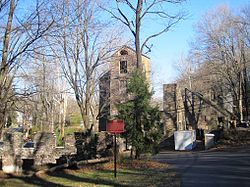Hood, Pennsylvania
Hood, Pennsylvania | |
|---|---|
Populated place | |
 Ruins of Robert Heath Mills | |
| Coordinates: 40°21′39″N 74°57′47″W / 40.36083°N 74.96306°W | |
| Country | United States |
| State | Pennsylvania |
| County | Bucks |
| Borough | New Hope |
| Elevation | 108 ft (33 m) |
| Time zone | UTC-5 (Eastern (EST)) |
| • Summer (DST) | UTC-4 (EDT) |
| Area code | 215 |
| FIPS code | 42-35558 |
| GNIS feature ID | 1203833 |
Hood is a populated place situated in New Hope, a borough in Bucks County, Pennsylvania.[2] It has an estimated elevation of 108 feet (33 m) above sea level and is located at the intersection of Mechanic Street and Sugan Road. Nearby the settlement are the Aquetong Creek and New Hope and Ivyland Railroad.[3] The site features ruins of the Robert Heath Mills, a grist mill built in the early 1700s.[4] The original name of this community was Springdale. [citation needed]
See also
Springdale Historic District (New Hope, Pennsylvania)
References
- ^ "Feature Detail Report for: Hood". Geographic Names Information System. United States Geological Survey, United States Department of the Interior.
- ^ "Hood (in Bucks County, PA) Populated Place Profile". PA Hometown Locator. Retrieved December 18, 2015.
- ^ Google (December 26, 2015). "Aerial view of Hood" (Map). Google Maps. Google. Retrieved December 26, 2015.
- ^ McNealy, Terry A. (Spring 2005). "Historic New Hope, Pennsylvania". Bucks County Town & Country Living. Greater New Hope Chamber of Commerce. Retrieved December 26, 2015.
[A] thousand acres of land were surveyed for a man named Robert Heath in 1700, covering the site of present-day New Hope. ... Robert Heath may well have chosen the location of his land grant because it included a stream that came to be known as Ingham Creek (from the name of a prominent landowner a century later), which provided a strong enough flow to power mills. ... A local road leading to Heath's mill is still called Sugan Road, so called for the "suggans" or saddle-bags used by farmers riding on horseback to carry their grain to the mill for grinding


